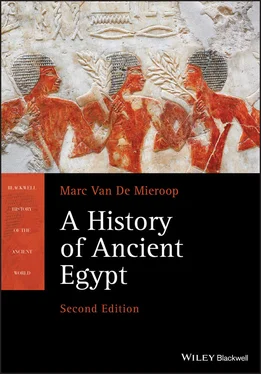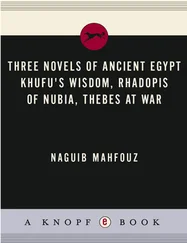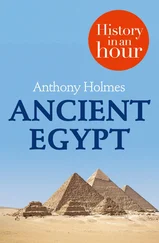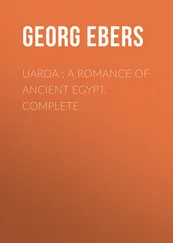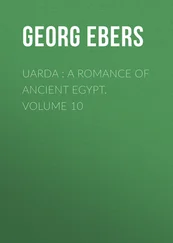The art and texts of the Early Dynastic Period refer to gods attested throughout Egyptian history, although it is unlikely that they had the same definition as in later times when the evidence is clearer. We encounter Horus and Seth, connected to kingship, the cow‐goddess Hathor (whose name means “Estate of Horus”), the fertility god Min, and other gods much better known later on. The annals report that the king visited their shrines or dedicated statues to them, and some archaeological remains of early temples exist. There must have been official ideas about their relationships and areas of competence that differed from Predynastic times, and officially sponsored gods gradually displaced local ones.
The newly established court formulated countrywide ways to express concepts such as temple, divine statue, etc. Whereas previously local traditions and preferences existed, the imposition of a union on the country led to common norms, at least in the official sphere. The later official Egyptian temple contained a limited set of small roofed rooms to house the divine statue, which one reached by crossing one or more courtyards, some open, others with columns that supported a roof. In Egyptian prehistory there was no uniform style of temple, however, and cults could focus on an earthen mound or a stone boulder, for example. The new form thus had to supplant existing customs.
Similarly, official Egyptian statuary – not well documented in the Early Dynastic Period but abundant in the Old Kingdom – followed strict rules of representation of the body that regulated the relative size of body parts, the position of the arms, and so on. In Predynastic times different conventions existed, which needed to be eliminated to make place for a common style. An example of an earlier tradition is a set of colossal statues of the god Min, excavated at his cult center Coptos. They show a style of human representation that is very unlike the dynastic one. They are gigantic (13.5 feet or 4.1 meters high), have unusual proportions, and contain inscribed signs that do not resemble those appearing elsewhere ( Figure 2.5). When complete they probably showed the god as bald and with a pointed beard. By the 2nd dynasty the new state had refashioned the image of Min to fit the common standards of divine representation. In general it instituted an official culture that gradually replaced the local traditions. The latter may have survived much longer than scholars usually suggest, but the novelty of a countrywide system was the result of the unification.
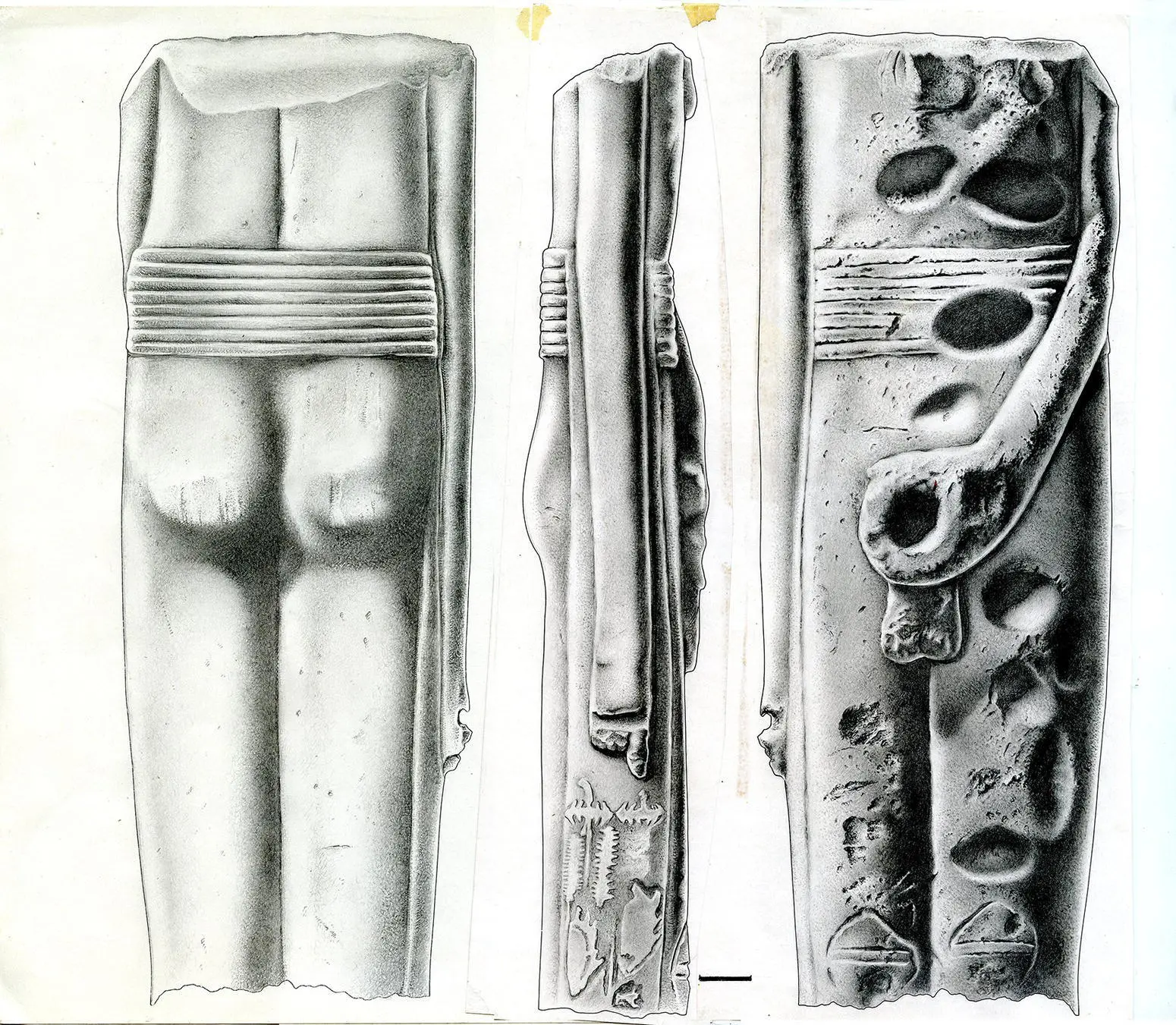
Figure 2.5 Excavations at Coptos revealed three statues dated around 3300 of the god of fertility Min, about 4 meters high and carved in limestone. They represent the god in an entirely different way from what would become the norm after Egyptian art forms became standardized with the creation of the unified state. The symbols on the statue’s legs are also unlike those used later on. Oxford, AM 1894.105e. From Barry Kemp, “The Colossi from the Early Shrine at Coptos in Egypt,” Cambridge Archaeological Journal 10:2 (2000), 211 ‐242: p. 212 fig. 1.
A state with Egypt’s expanse required a structure that enabled the collection of resources and the communication of central demands throughout the territory. The strong focus on the king made the state’s administration very centralized. Officials owed allegiance to him, not to an abstract concept of the state. As was the case for kings, we know officials best through their burials. At Saqqara, the cemetery overlooking the city of Memphis, appear a number of substantially sized mastaba‐tombs of high officials and members of the royal family dating to the 1st and 2nd dynasties. The officials sometimes listed their titles, and their names appear on the labels found in royal tombs, which indicate that they were responsible for a delivery. These short writings show that a bureaucracy existed from the foundation of the Egyptian state onward. The number of officials’ tombs is relatively small, however, and it seems that the administration was not yet extensive. But it was the precursor of later Egyptian bureaucracies.
The men’s duties included the collection of resources from all over the land. From the late Predynastic period on, royal tombs at Abydos accumulated goods from distant places. The labels found in tomb U‐j seem to contain the names of estates from Upper and Lower Egypt whose produce was sent to support the buried dead. Throughout Early Dynastic times and later on, the concept survived that domains in various parts of Egypt were set aside to provide for the king, in life and in death. Production in them was organized in such a way that a surplus existed for that purpose. Ideologically their countrywide distribution reaffirmed the king’s role as a unifier of the land. At the same time, all other producers probably owed some type of dues – in kind; currency did not exist – to the court, which administrators collected and used in support of the state’s infrastructure. In order to assess the amounts each region could provide, the court undertook censuses. The “Following of Horus” event commemorated regularly in the Palermo Stone annals seems to have been such an exercise, while a biennial cattle count took place starting in the early 2nd dynasty.
From the Early Dynastic Period on, Egypt was subdivided into units that we call nomes, after the Greek term for regional administrative districts. Each nome had its territory, name, and symbol, a system that was fixed by the 5th dynasty and survived into the Graeco‐Roman Period, albeit with changes over time. An official was responsible for them and represented the king locally. The nome‐system enabled the administration of the country in a methodical and uniform manner. It made it easier to assess dues and to deal with local issues. The drawback for the king was that officials – we call them nomarchs, a modern designation that takes into account multiple ancient Egyptian titles and disregards temporal changes – could develop a local power base, which in times of weak central government enabled them to gain autonomy.
At the apex of the entire bureaucracy was the king. The center of the state was wherever he was. Manetho, who lists the capital of each dynasty, states that the first two dynasties were from This or Thinis. Since all kings of the 1st dynasty and two of the 2nd were buried at Abydos and kings were buried near their capital in later periods, we locate the ancient city in Abydos’s vicinity, probably beneath the modern town of Girga, where it is impossible to excavate. The capital’s position near Abydos suggests that the dynasty 0 lords buried there were the main forces behind the unification of Egypt, but its location was too far from the Delta to be strategically ideal. It is thus no surprise that the administrative capital of Early Dynastic Egypt was farther north, at Memphis alongside the officials’ burial site at Saqqara. In the Old Kingdom Memphis did become Egypt’s political capital. The city was perfect for that purpose as it lies just south of where the Nile Valley and Delta meet, and the early high administrators of the state were in closer contact with the two parts of the land there than at Abydos. One of the ancient names of the Memphis region was Ankh‐tawy, “The Life of the Two Lands,” which reasserted the ideological union of Upper and Lower Egypt.
The ideology of the Early Dynastic state thus incorporated all the elements that defined ancient Egypt for 3000 years or more afterward. It was a union of Upper and Lower Egypt held together by the king, whose powers as an incarnation of the god Horus ensured order in the universe. Official norms and beliefs had a countrywide impact: The gods were organized in a single pantheon, official art and architecture adhered to court standards, and all people in Egypt handed over part of their labor to the state. An administration carved the country up into units and collected dues, while embodying the king’s power locally.
Читать дальше
